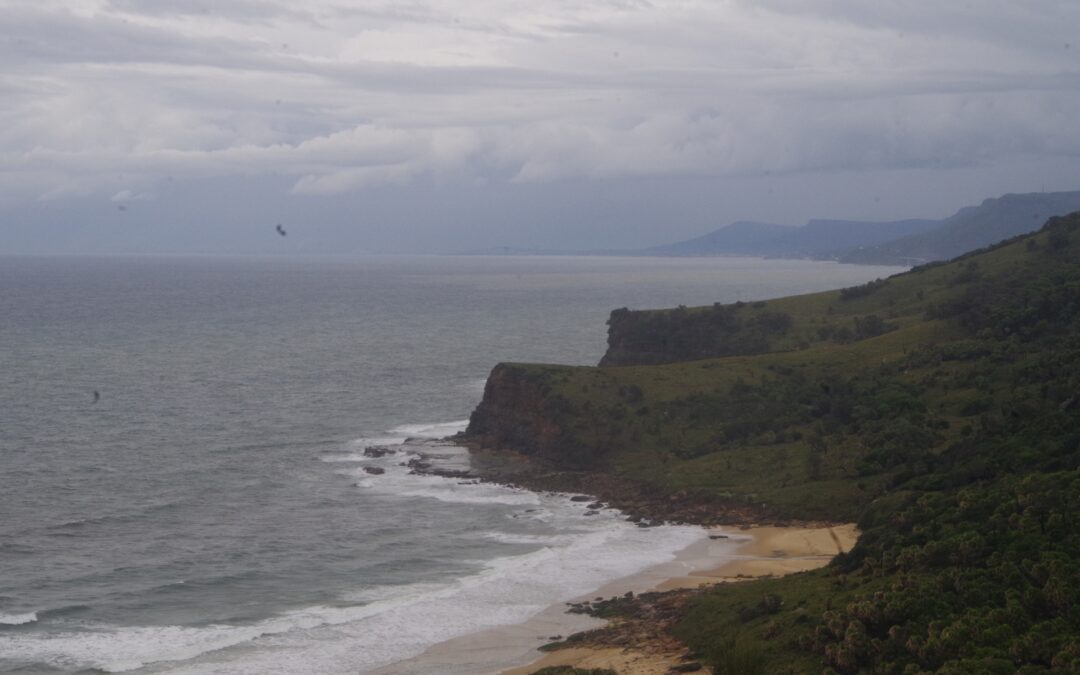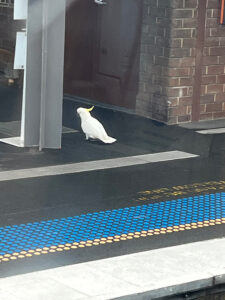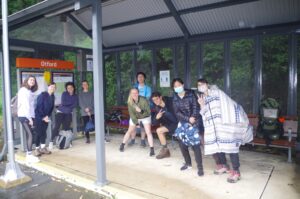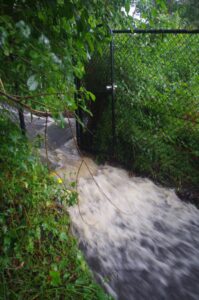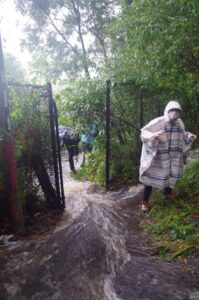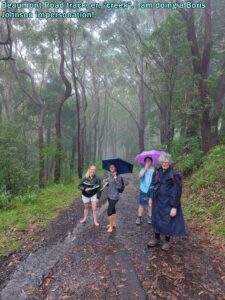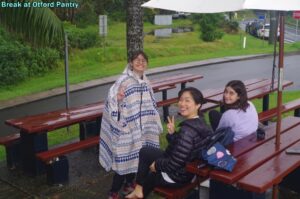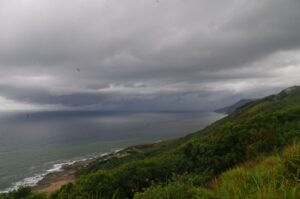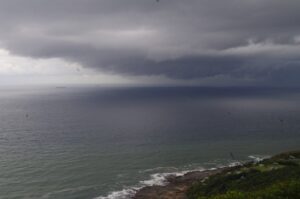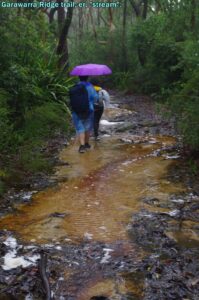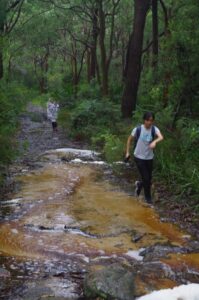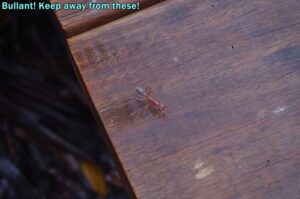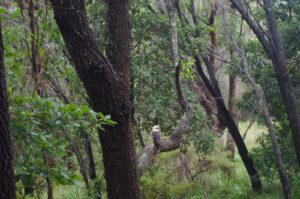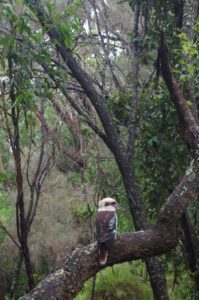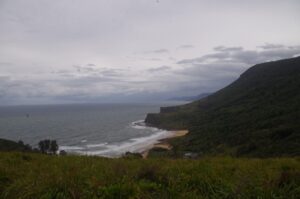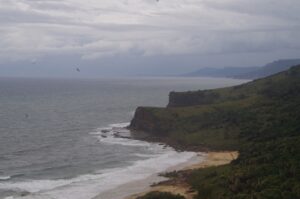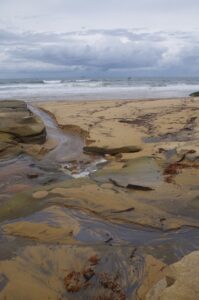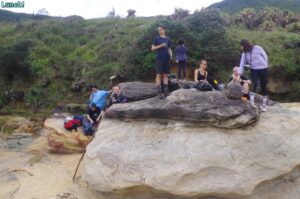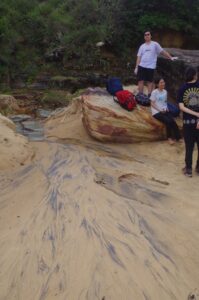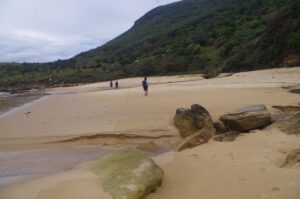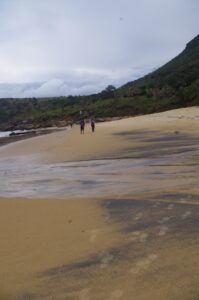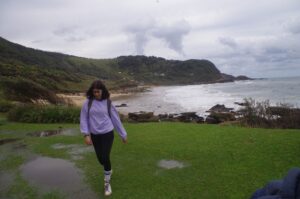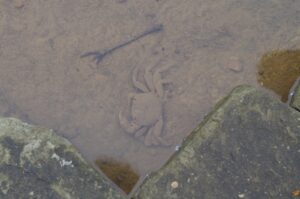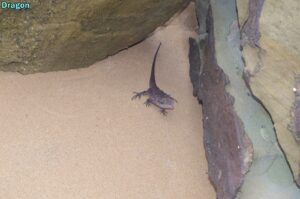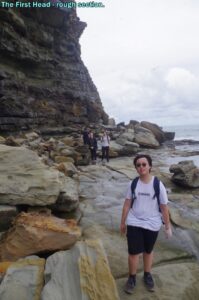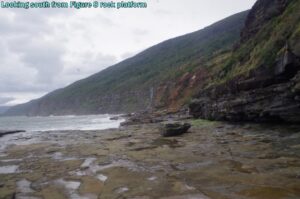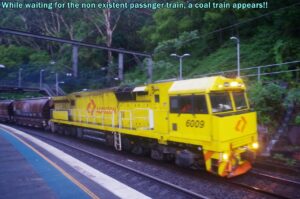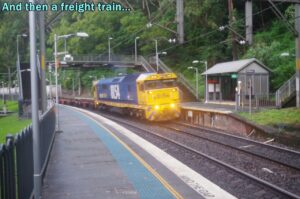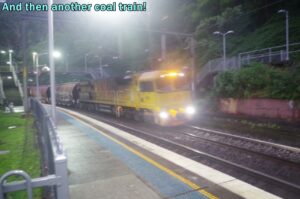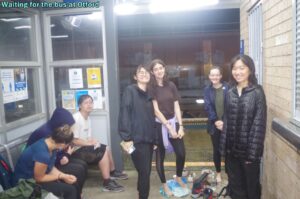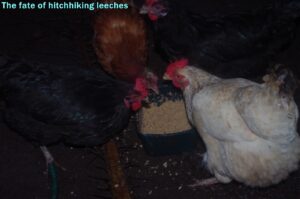Date: 26/3/2022
Trip leader: Bruce Stafford
Party: Hei Lam, Jenna, Joyce, Justine, Maria, Muriël, Robin, Toby.
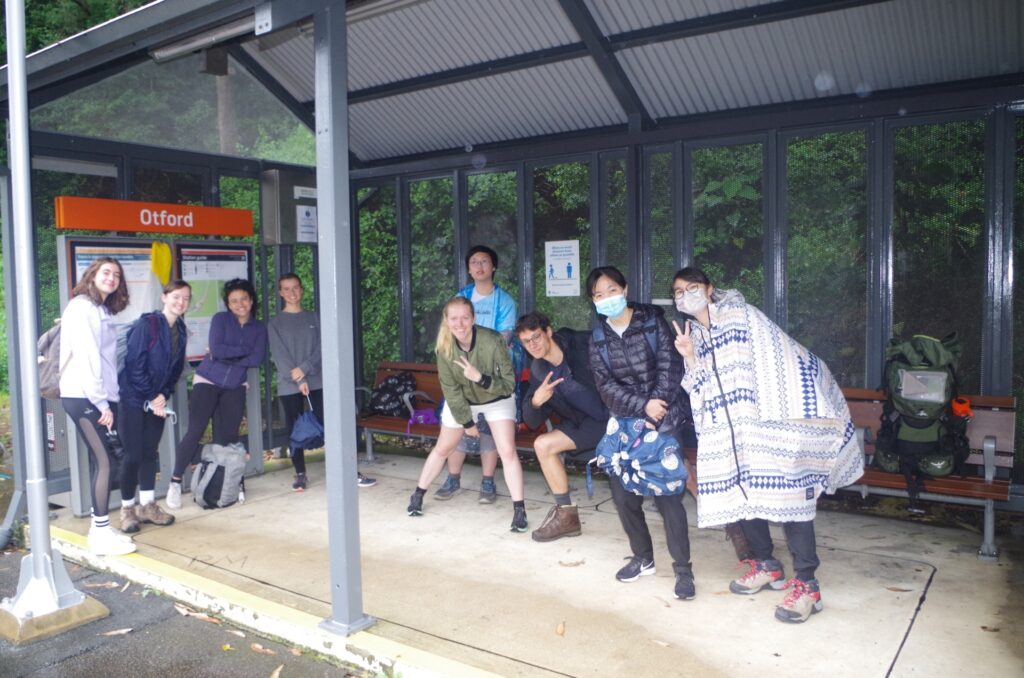
Burning Palms-Otford, Royal National Park.
This walk was transferred from the following Sunday (27/3) and checking the rain radar it looks like it was a wise choice, even though we got a few showers on the actual walk.
Although 14 signed up we had two drop out sick, one slept in, and one apparent “no show” (who has since explained that he was in Covid isolation), leaving 10 to complete the walk. We met up at Central and off we went to Otford Station. It turned out that Maria was running late but still managed to get on the train at the last minute or so (she caught up with us at Otford).
At Sutherland a couple of the group were amused to see a Cocky (White Cockatoo) on the overhead wires and then it flew onto the station platform. All the way to Helensburgh from Central there was no rain at all, but just as we departed Helensburgh the rain started bucketing down! We got off at the next stop, Otford, and went straight for the shelter shed on the platform. Fortunately the rain started to ease off after a few minutes, but not the after-effects. On leaving the station the steps at the gate had transformed into a cascade (see photo). Some acrobatic balancing was done to try to get around it, but given what we would come across later, it was a waste of time avoiding getting shoes and socks wet. The steep pathway up Beaumont Road to the main road had also become a torrent. Finally at the top the rain had stopped and we headed off to the nearby Otford Pantry for coffees and a loo break for some.
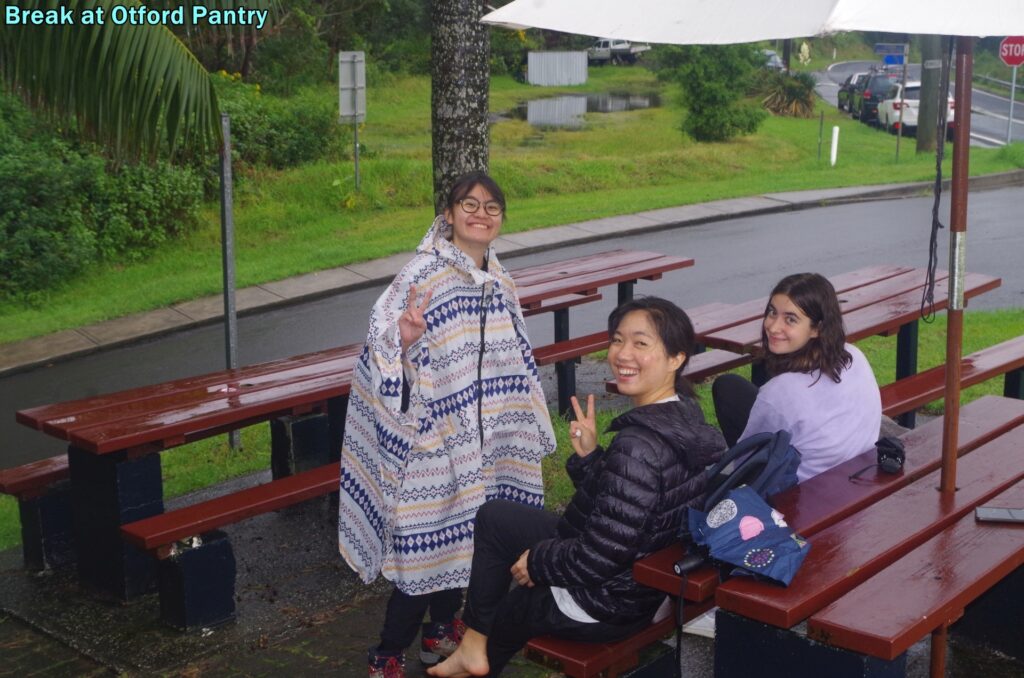
After a short break there we head off along Lady Wakehurst Parkway to Otford Lookout. This is where Robin discovered the first of the many leeches we would accumulate. After Otford Lookout the track continued along with some welcome improvements on the formerly very rough track that leads up to Werrong Lookout. From here the track undulates a bit until heading steadily downhill on a new elevated pathway to reach the start of the Garawarra Ridge Trail. This is where the fun started. This trail was under water for much of it’s length, with the track becoming a stream in many places. It was also very muddy where it was not a stream. Because of the recent weeks of heavy rain, the ground is already saturated and the rain water just forms a stream on top. After a lot of this we eventually reached Garawarra Farm carpark for a short rest. There we spotted a red bullant on the picnic table. Whenever you see one of these, keep clear! They give a very painful bite from Formic Acid in their pincers.
Then it was off on the track down to Burning Palms Beach. On the way we saw a Kookaburrra perched on a tree, then it saw something in the grass and pounced down on it. Shortly after the track opens up to views over the coast and the Beach. The seas appeared to have a slight 1 metre well as predicted which was a good sign. From there the track drops down to the shacks behind the beach and Robin got advice from a faimily in a shack that the best path down to the beach was a little further on, not the one which leads to the surf clubhouse. I noticed also that a new elevated track is replacing the older metal track through this location. Also noted a sign: “beware of snakes”.
The track drops down to the beach which has been badly eroded after a series of storms in the past several weeks (the sand will eventually find its way back). This has exposed several strands of mineral sands, the darker grey sand seen in the photos. A dry large rock was found to be suitable for a lunch spot. While there Muriel asked ifthere was anywhere to swim. The beach had no flags up and was therefore closed, and what’s more there was a rip right in front of where we had lunch. I suggested that maybe it might be possible to swim in Figure 8 Pool.
So after lunch we headed off for Figure 8 Pool. This meant crossing the boulder field in the middle of the beach which in normal times is covered by sand and easily managed. We wanted to avoid having to wade in the surf to get around it, but given what we would encounter on the Coast Track later on, we may as well have done this (and thinking back, the salt water would have been a deterrent to the leeches we were accumulating). Further on was te short boulder field befre the rock platform near the First Head, and on it we saw some sea life that too often gets illegally caught by tourists going there, like crabs. There was a Water Dragon there as well (the only one we saw all day). By the time that we got to First Head the tide was already 3 hours into rising, but as it was not going to be a major high tide I wasn’t too worried – then. Even so, waves were beginning to break over the “easy” section there, so passage around it by the harder section was needed. Then it was off along the boulder section which covers the several hundred metres between there and the rock platform within which is Figure 8 Pool. On arrival at the platform, it was clear that the tide had risen far enough to put Figure 8 Pool under water and so couldn’t really be seen or accessed without wading in knee-deep water. At least there were only small waves breaking over the rock shelf at that time.
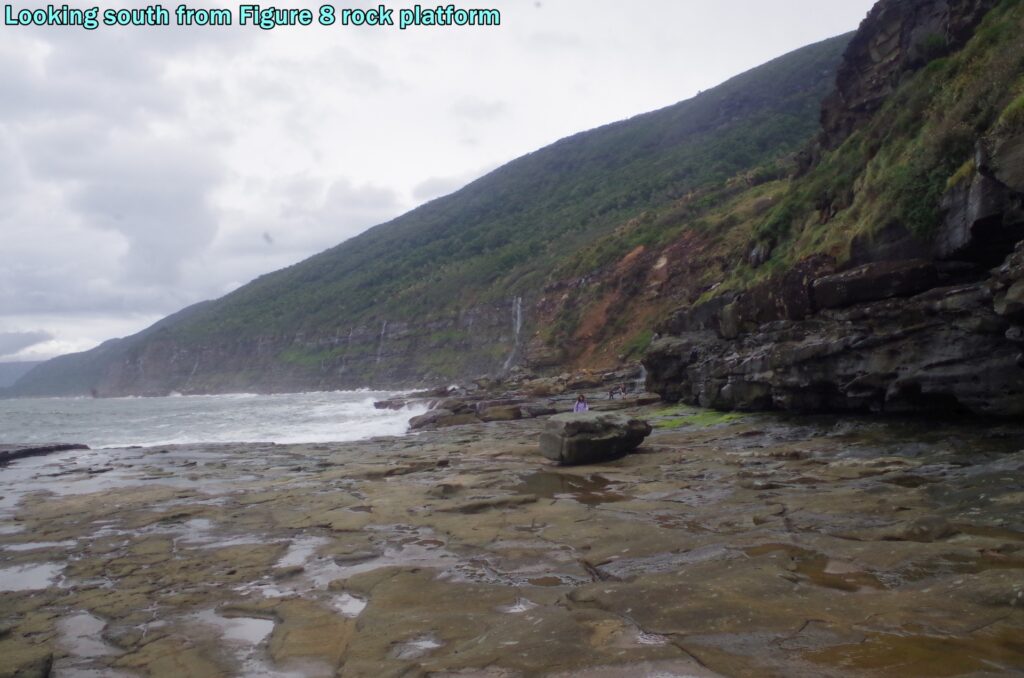
Clearly the trip to see Figure 8 Pool was in vain, but straightaway I noticed we were missing 3 people. What had happened was that three people had “powered on” ahead of the group after we passed First Headland, and on arriving at the rock platform under Second Headland where I said earlier was the location of Figure 8 Pool, could not see anything which looked like a Figure 8. So they had just kept going. And kept going…and going! In fact over 300 metres further on. So there was nothing to be done but just wait 15 minutes while thay made their way back, gingerly now as the sea swell had suddenly started to increase, and so did the wind. A sudden drop in temperature told me we were about to get some rain, the first since the rain shower at Otford Station. Because of the sudden change in the weather I told the group that we needed to return to the beach as soon as possible. Unfortunately the rain arrived just as we were crossing the boulder field between Second and First headlands, making formerly dry boulders suddenly slippery. Toby in fact had acquired a graze on his leg from a slip on a boulder earlier on.
(I will comment further later about “powering on ahead” on walks).
We had lost some time because of the need to avoid the rock platforms which normally make progress somewhat faster, but reached the grassy section at the south end of the Beach ok, only to find that grassy section itself completely saturated. From there we dropped down on a muddy track and in the process Toby wrecked his umbrella, still up as the rain hadn’t stopped yet. Then we had to cross Robin Rill were it entered the sea, and because of all the rain it was running strongly (normally it’s only a trickle which is why it’s called a rill). Then the track from the beach goes beside Robin Rill, but the volume of water coming down the Rill had taken over the track! Therefore there was no choice but to wade in the Rill itself to reach the Coast Track. The only alternative was to return the long way round over that awful boulder field in te midle of the beach to get to the Coast Track. So by now everyone’s shoes and socks were thoroughly wet, but that was only the start of it. The Coast Track was the next trial.
At first there were no major issues for quite a while. There was a sodden section where a new section of ground had been cleared in readiness for the new elevated pathway there, but soon the existing elevated pathway appeared and it was easy going up and over the ridge of the First Headland. Then we arrived at Palm Jungle, and the fun started! The track was just not only its usual muddiness on wet days, it was in many places completely underwater with streams running along it. Sometimes it meant wading in ankle-deep water and going around obstacles. Icould see why we didn’t see a single tourist along this section al all. Thankfully the rain had stopped, with only a very light shower later on. Even so, the vegetation was sodden and continued to drip water onto us. There were a couple of places where the track was very slippery and helping hands enabled people to get across without slipping and sliding. Despite all the water around us we still needed a brief water break as we headed up the hill. It was with relief that I started seeing Gymea Lily plants which indicated that we were near the top of the climb. The last section was along the original track cut through the sandstone in the late 19th Century, being the Old Lilyvale Track. Just past Werrong Lookout the track again becomes an elevated walkway which soon comes to its junction with the Garawarra Ridge Trail. (there are no photos of this section along the Coast track as the drizzle and dampness required cameras and phones to be stowed away under cover in packs).
On regaining the Ridge Trail we again had to walk through the water and muddy sections to get back to Otford Lookout, along the same way we had come in the morning. At least we had no more rain until reaching Otford Station. We had done the walk from Burning Palms to Otford Lookout in 2 hours 10 minutes which was a quite respectable time given the horrible condition of the track (it’s the same time that “Wildwalks” site quotes for this section – downhill without breaks on a good day!).
At the Lookout the time was 5.13pm which in theory have us enough time to just get to the Station for the 5.30pm train to Thirroul and then a fast train to Sydney. On checking Tripview however we found that train services had been suspended due to flooding on the tracks at Helensburgh and a replacement bus service was replacing trains from Thirroul to Waterfall. We arrived at Otford Station and found that the “powering on” people had arrived there at 5.10pm and also discovered there were no trains. The “powering on” had been in vain! We got on the station help phone and the railway staff at the other end advised that a bus had left Thirroul about 5.30pm and would take about 20 minutes to get to Otford. The twenty minutes came and went so the help line was contacted again and they apologised that the bus had been prevented from reaching Otford because of a flooded causeway and they were waiting to see what could be done. Meanwhile we were surprised to see a long coal train pass through on the opposite platform, then a freight train 10 minutes behind that, and then another short coal train behind that which stopped at Otford (not of any use for taking passengers!). I noted that at Otford these Wollongong-bound trains were being switched to the opposite track which suggested more partial flooding problems further down the line, and that proved to be the case. Thus with no prospect of the trains recommencing we just had to wait it out at the Station. Two other independent walkers had joined us there as well. Time was spent pulling leeches off our feet. Even at the station we weren’t safe from leeches as some appeared even there looking for people to bite! I told the group that if I found any more on me at home I would feed them to the chooks. That got puzzled looks until I explained that a chook is a chicken.
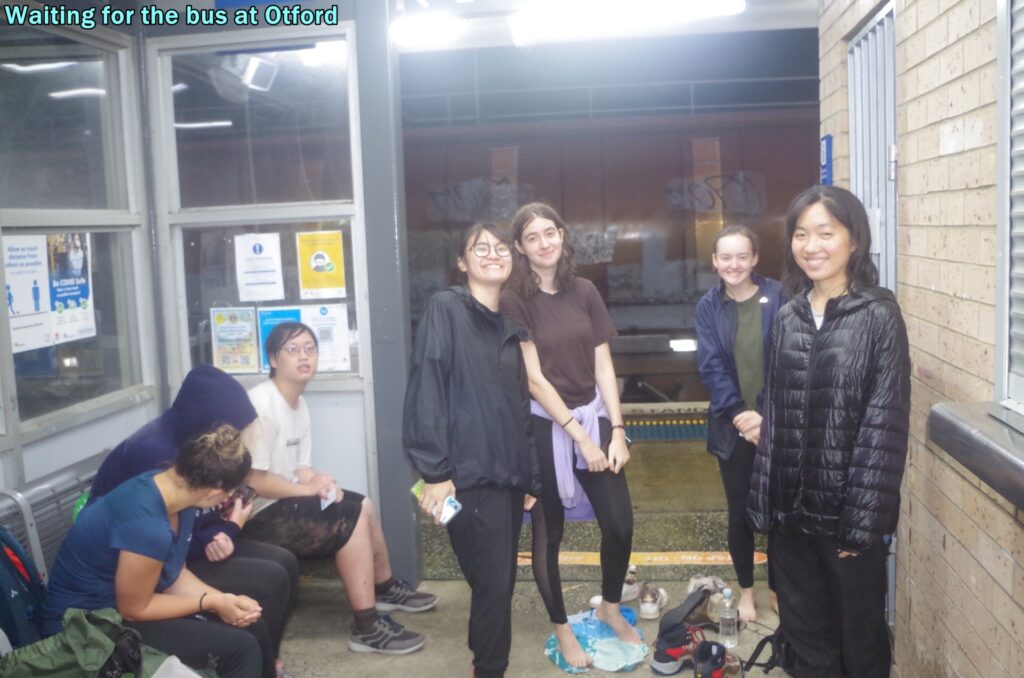
At 7.20pm the bus finally arrived and took us via Helensburgh to Waterfall Station where we got on a suburban train for the one hour trip back to Central. We got at about 9.10pm, three hours later than expected. Everyone seemed happy with the walk despite (or maybe because of) the various adventures; something for the overseas students to tell family and friends back home. Nobody really freaked out about the leeches, and I found six more on my feet and put them in a jar to feed to the chooks the next morning.
I said that I would discuss “powering on ahead” on walks. The simple answer is: Please DON’T. The least thing that can happen is that people who ‘power on” can get reputations as “show-offs”. And you only end up having to wait for the rest of the group, so why bother getting ahead? It can have more serious consequences though. It is important that the group stick together to keep an eye on each other as this is a safety issue. Some people are slower walkers than others and this is OK, just as long as they don’t get too far behind by stopping to take selfies – that can be annoying. Also the trip leader might have to be at the rear of the group to ensure everyone is OK. If you get so far ahead that you can’t see the rest of the group you must stop and wait for them to catch up. If there is any doubt as to which way to go if you find yourself in front, contact the trip leader on the phone for advice. Don’t make assumptions and also don’t take instructions from random independent walkers you might meet; they are not your trip leader! The trip leader needs to know where everyone is until the group meets up together for the train home, or if driving, where the cars are parked. After all, some people might be missing because they have been bitten by a highly venomous snake or fallen down a cliff. In the past some people have “powered on” ahead of the main group to a railway station and just hopped on the first train that arrived without letting the walk leader or anyone else know what they were doing. That is very bad manners. I am aware that some people might be from cultures where “individualism” is encouraged, but that does not work on bushwalks; you must remain part of the group.
One other thing, don’t ask walk leaders for contact details of other people in the group. It is not permitted under USU privacy rules, as contact details are for use ONLY for the purposes of walk organisers contacting members about the walk, and not for use by third parties. One person who is now an ex-walk leader used contact details he had obtained from walk participants to invite them to dinners at his relative’s restaurant. As I said, he is now an ex-walk leader!
Now back to further possible trips to Figure 8 Pool: one might be possible on 30th April or 1st May depending on the weather, which you will have noticed has been very wet lately. At least the tides will be more favourable that weekend.
Bruce Stafford.
Admin note: edited to remove a name on request

